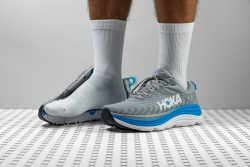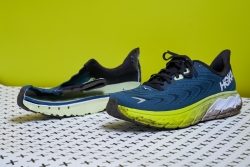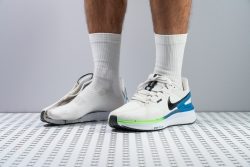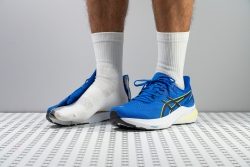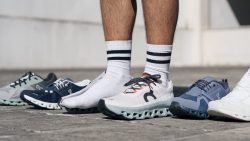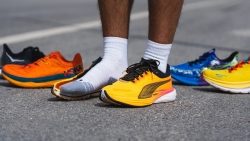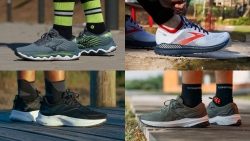7 Best Running Shoes For Plantar Fasciitis in 2024
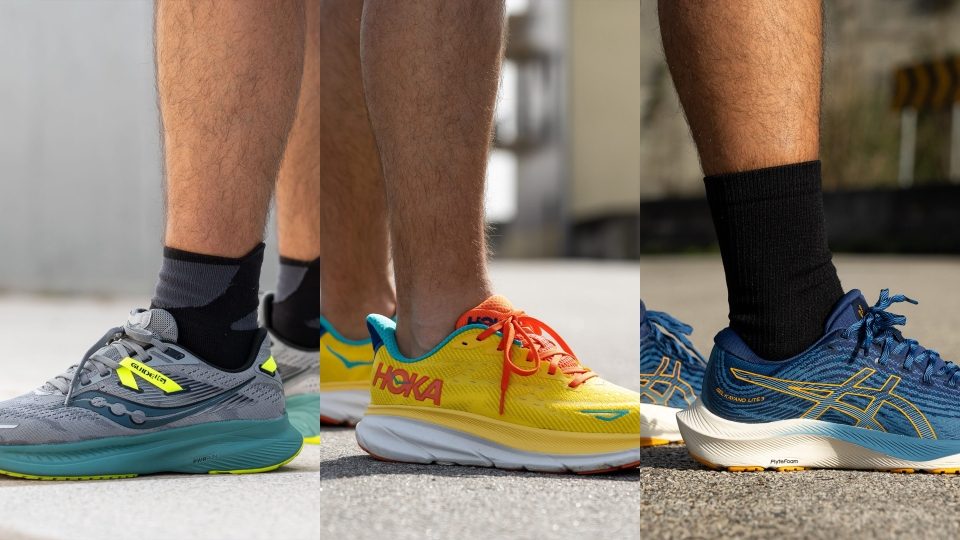
Based on studies, plantar fasciitis affects 1 in every 10 adults, both men and women. Whether you are an athlete or not, one of the ways to reduce plantar fasciitis is to wear comfortable shoes.
In our lab and on the runs, we have tested running shoes that are recommended for plantar fasciitis to help you find the best ones. And because you may have preferences regarding the level of support, cushioning, or price range, we have selected our top picks in different categories.
And if you want to learn more about this foot condition, read our in-depth article on plantar fasciitis and how to deal with it.
How we test running shoes
Foot pain is no joke. It is our mission to help you find the best shoe to alleviate the discomfort of plantar fasciitis. Given our extensive knowledge base, we have developed a comprehensive review methodology to find out which shoes work the best.
- To avoid bias, we purchase all running shoes with our own money.
- Log at least 30 miles in each pair, indoors and outdoors, and on roads and trails.
- Cut the running shoes open and measure 30+ different parameters.
- Summarize our data and observations all in an extensive review.
Best running shoes for plantar fasciitis overall









































What makes it the best?
The Adrenaline GTS 23 is hands down the best overall shoe for people with plantar fasciitis. It has rock-solid support, ample cushioning, and high heel to toe drop that are ideal for runners who need that added bit of protection for their feet.
And it's hard to find shoes that keep feet protected as well as the GTS 23. Its GuideRails system did a great job keeping the foot from rolling too far inwards or outwards during our runs. The shoe's midsole width in the forefoot and heel are also 4.5 mm and 7 mm wider than average, and we appreciated the safe landing platform that the wide base provided.
The GTS 23 has a good amount of cushioning in the heel with 34.1 mm of foam, which we measured to be 20.7% softer than the average shoe. That combination of cushioning and comfort makes the GTS 23 ideal for cruising along in easy runs.
The GTS 23 also has a 12.6 mm heel to toe drop, which is 41.5% taller than the average running shoe. This is great since shoes with a higher drop help to put weight more in the forefoot and away from the plantar in the heel.
However, the GTS 23 doesn't quite hold up in terms of toebox durability. The shoe scored 1 out of 5 as the mesh upper was significantly destroyed in our standardized Dremel test. So those looking for a shoe with a more durable upper better look elsewhere.
Pros
- Excellent stability without being intrusive
- Ideal for easy miles
- Specifically designed for heel strikers
- Outstanding breathability
- Comfortable and cushioned
- Availability in narrow and wide sizes
- Capable of handling tempo paces
- Not expensive at all
Cons
- The engineered mesh upper lacks durability
- Lacks cushion for forefoot strikers
Running shoes for plantar fasciitis with the best cushioning









































What makes it the best?
The Glycerin GTS 20 is the stability version of Brooks’ popular and versatile daily trainer and is just as reliable and comfy. This incredibly supportive shoe pampers our feet throughout our daily runs. It’s truly second to none as having the best cushioning for plantar fasciitis.
With a durometer reading of 23.4 HA, the Glycerin GTS 20’s midsole is about as soft as our current lab average. However, the shoe’s robust stack, which we measured to be 0.9 mm and 3.1 mm higher than average at the forefoot and heel respectively, means we had lots of protective foam underfoot during our test runs. The result is a ride that feels extremely protective and softer than the durometer leads us to believe.
Additionally, the Glycerin GTS 20 employs Brooks’ GuideRails system, in the form of firm pieces of foam integrated into either side of the midsole, for excellent support and stability. This manifests itself in a high level of torsional rigidity, which we scored 4 out of 5 in our manual assessment. By mitigating how much our foot is able to move laterally, the shoe helps us maintain proper alignment during our stride and, in that way, prevents worsening any foot injuries.
Tipping the scale at 10.9 oz (309g), the Glycerin GTS 20 is certainly a chunky monkey. This is especially the case for those used to neutral road shoes, which on average weigh 9.42 oz (267g). Even stability shoes tend to weigh in under 10.6 oz (300g).
Pros
- Excellent for heel strikers
- Provides protective cushioning
- Offers comfort on easy running days
- Ensures smooth transitions
- Features a secure heel counter
- Comes with a soft, stretchy upper
- Good breathability
- Effective GuideRails system
Cons
- Midsole may feel overly firm for some runners
- Pricier than many alternatives
- On the heavier side
Running shoes for plantar fasciitis with the best stability
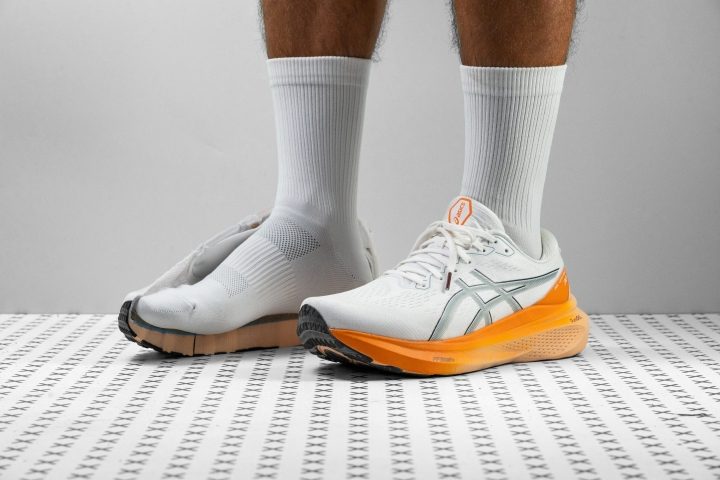














































What makes it the best?
Those of us with plantar fasciitis greatly appreciated the 30th Gel Kayano’s one-of-a-kind stable ride. Its substantial amount of well-loved FF Blast+ cushioning felt like home, while its 4D Guidance System maintained our proper foot alignment. Even our lab results agree that it’s hard not to love this shoe’s perfect balance of comfort and support.
GK30 aced its support features, namely the 4D Guidance System and the extensive landing base. It uses a softer foam under our arches for custom support and protection. This relieves the pressure, effectively preventing inflammation and pain. Ensuring steady landings is the extra wide forefoot and heel that has an extra 10.9/15.1 mm vs. the average.
This ASICS redefined the traditional stability shoe by adding tons of comfort to its midsole. With a tall stack packed with the brand’s softest cloud-like foam, the ride feels so luxurious and forgiving. We ran long miles without counting since our legs remained fresh. Our durometer confirms it’s 30.2% softer than average. Adding to GK30’s charm is the top-notch breathability of the well-ventilated upper., making it a pleasant place to be in for long hours.
Unfortunately, this maximalist weighs a heavy 10.7 oz (303g). Not everyone needs this much cushioning. We recommend checking for lighter options that also offer stability.
Pros
- Exceptionally cushioned
- Impressively stable with 4D Guidance System
- Lighter than it seems
- Top-notch breathability
- Effective maximalist design
- Superior durability and comfort
- Ideal for high-mileage runners
- Ultra-plush FF Blast+ foam
- Amazing build quality
Cons
- Actual drop exceeds stated measurement
- Midsole might require a break-in period
Best running shoes for wide feet and plantar fasciitis













































What makes it the best?
In our test runs, Hoka Gaviota 5 delivered a comfortable in-shoe experience and consistent support suited for runners with instability and arch issues. Its cushioning is a strategic combination of firm and soft elements to provide comfort and surefootedness, while the wide midsole and unrestricted upper are extra accommodating. Our lab agrees that Gaviota 5 perfectly fits the needs of wide-footed runners with plantar fasciitis.
Each footfall of ours was caught by a generous amount of cushioning underneath. It saved our legs from feeling bruised due to repetitive landings and kept the ride smooth sailing and centered. The plush 12.9 HA layer enhances comfort, while the second firm 22.0 HA foam ensures controlled strides to prevent injuries.
The inclusive midsole measures 11.7/16.3 mm wider than average in the forefoot and heel so that our landings are safe and sound. Another stability element is the H-Frame that guides our foot alignment so we don’t roll our ankles and move excessively.
We never endured the cramped-up feeling since the spacious toebox and airy upper feel refreshing. We had room for natural toe splay and optimal airflow to prevent hotspots and blisters. Our smoke and light tests confirm a perfect rating in terms of breathability.
Its minimal 2.2 mm drop may bring discomfort to heel-strikers. We warn caution to runners who aren’t used to low-drop shoes.
Pros
- Remarkably stable
- Breathable and comfortable upper
- Lightweight for its size
- Plushier than ever
- Good stability option for forefoot strikers
- Ideal for wide feet
- Excellent for long runs
Cons
- Low drop might pose issues for heel strikers
- Performs poorly in colder conditions
- Not for narrow feet
Best lightweight running shoes for plantar fasciitis
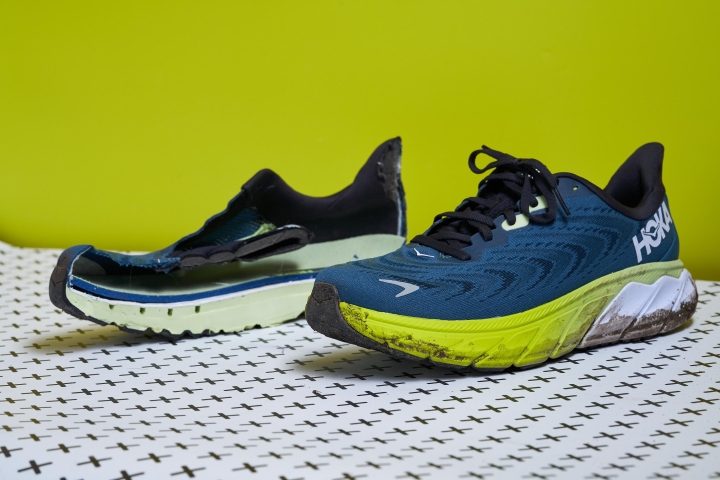



















What makes it the best?
Hoka redefines the traditional heavy stability shoe with Arahi 6. A breath of fresh air on our feet, it offers consistent and subtle support through its balanced cushion and vast platform. The lab results show this but it's our actual runs that cemented Arahi 6 as the best lightweight shoe for runners with plantar fasciitis.
While most stability shoes weigh above 10.0 oz (283g) and the average running shoe is 9.5 oz (268g), Arahi 6 boasts a feathery 8.9 oz (252g). With its high-density foam and spacious platform, we’re surprised by how airy it is.
Zooming into the midsole, Arahi 6 integrates the J-Frame technology — a firmer J-shaped foam outside the midsole for better balance and support. To enhance comfort, Hoka provides enough stack to mute out ground feel. It’s notably higher than average in the forefoot leading to a more leveled 4.1 mm heel drop. We noticed a more even weight distribution and less localized tension.
Further ensuring a steady ride is the platform that runs 2.1/7.4 mm wider than average in the forefoot and heel. This gives all types of foot-strikers enough room to land more stably.
We’re not too convinced with the outsole as it lacks the coverage to last long and the soft rubber for reliable grip.
Pros
- Fits true to size
- Balanced cushioning
- Lightweight for stability shoes
- Good lockdown
- Stable platform
- Fun to run in
- Very comfortable
- Improved lacing
Cons
- Grip is not reliable
- Durability problems
Most comfortable running shoes for plantar fasciitis
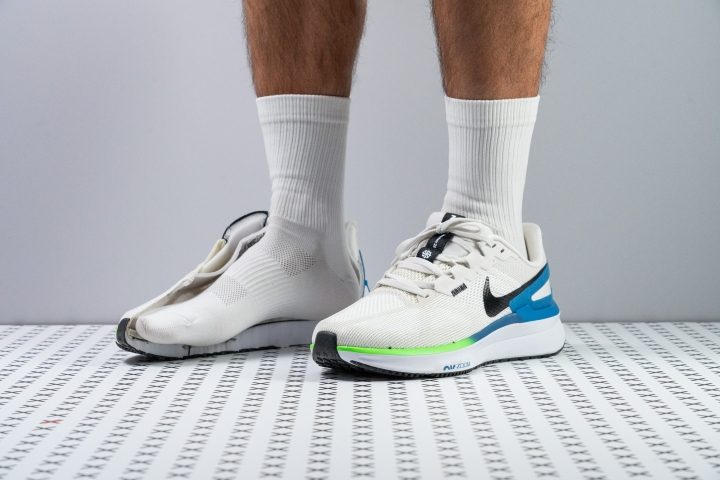











































What makes it the best?
Contrary to its name, Nike Structure 25 is devoid of any rigid sidewalls and shanks, carrying a cushioned midsole instead. We were pleasantly surprised by how it seamlessly combines a smooth and stable ride with gentle, non-intrusive elements that help align our feet, making it particularly well-suited for runners dealing with plantar fasciitis who require additional comfort.
Home to Nike’s Cushion 3.0 foam, we enjoyed pillowy landings and slightly springy toe-offs. Our lab reveals the cushioning is a combination of height and plushness, maximizing its potential for comfort. Our caliper shows the stack rises to 36.7/24.6 mm while our durometer confirms our sensation with a soft 17.0 HA reading. We found the shoe to be supportive for easy runs up to LSDs.
Our forward motions feel effortless due to the malleable midsole, which our bend test reveals is 24.6% more flexible than average. To ensure our strides remain balanced and stable, Structure 25 adds width to its base and stiffens the midsole torsionally. Our manual assessment reveals a 4/5 score, making it almost impossible to twist our ankles. Meanwhile, the midsole is a wide 116.4/95.3 mm.
However, the dense and padded upper makes us crave more airflow during warmer days. This pair feels comfiest during cooler seasons.
Pros
- Stable and supportive ride
- Plush and protective cushioning
- Comfy and flexible underfoot
- Consistent in the cold
- Good for long slow distance runs
- No break-in required
- Warm and roomy toebox
- Durable, high-quality upper
- Lots of colorway options
Cons
- Quite heavy
- Average breathability at best
- Clunky at high paces
Best value running shoes for plantar fasciitis













































What makes it the best?
After miles of running and hours of lab testing, the ASICS GT 2000 12 reveals itself as our top-value shoe for people with plantar fasciitis. This lightweight stability shoe delivers features beyond its $140 price tag. It has the right combination of gentle support and comfortable cushioning that protects and relieves plantar fasciitis-afflicted runners.
At 9.7 oz (275g), the GT 2000 12 is lighter than the average stability shoe (10.3 oz/293g) due to its less pronounced supportive elements. Its 3D Guidance System combines a wide landing base with a strategic midsole geometry to promote surefootedness. Our caliper confirms the forefoot and heel are 6.1 mm wider than average. This innovation is non-intrusive as it didn’t demand much attention, yet we knew it was certainly there when needed.
What’s hard to miss is FF Blast+ cushioning’s balanced and responsive ride. Our durometer shows a 25.1 HA measurement, just the perfect amount of firmness for support. To elevate comfort, GT 2000 12 integrates the PureGEL into the heel to soften landing impact and relieve pressure off our heels.
However, what we find lacking is a more breathable shoe for warmer days. We recommend using this pair for cooler weather.
Pros
- Stable yet non-intrusive
- Exceptionally grippy and long-lasting outsole
- Built for endurance on long runs
- Lightest model in its series
- Top-notch comfort
- FF Blast+ cushioning for the first time in a GT 2000
- PureGel technology for heel strikers
- Remarkable durability of the outsole
- Great value at $140
Cons
- Breathability could be improved
- Might require a brief break-in period
What is plantar fasciitis?
Plantar fasciitis is the pain in the arch of the foot that is caused by the inflammation of the plantar fascia, a thick ligament that connects the heel and the front of your foot. The repetitive pressure on the ligament can cause lots of small tears that result in pain and inflammation.
Those who are suffering from this foot condition often notice acute pain in the morning, after a running session or after exercise. The pain also tends to become unbearable when standing for a long period.
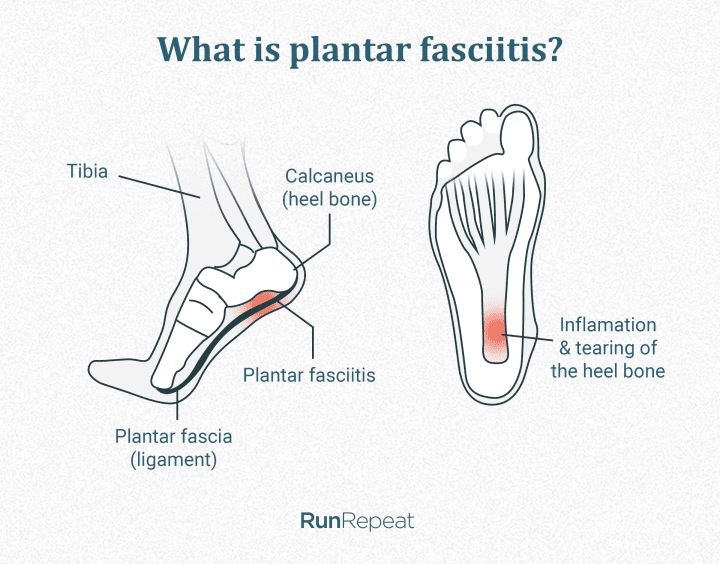
5 expert tips to find the best shoes for plantar fasciitis
If you are experiencing plantar fasciitis, your goal is to find a comfortable running shoe that is cushioned and at the same time, supportive. In finding the right pair, consider these tips:
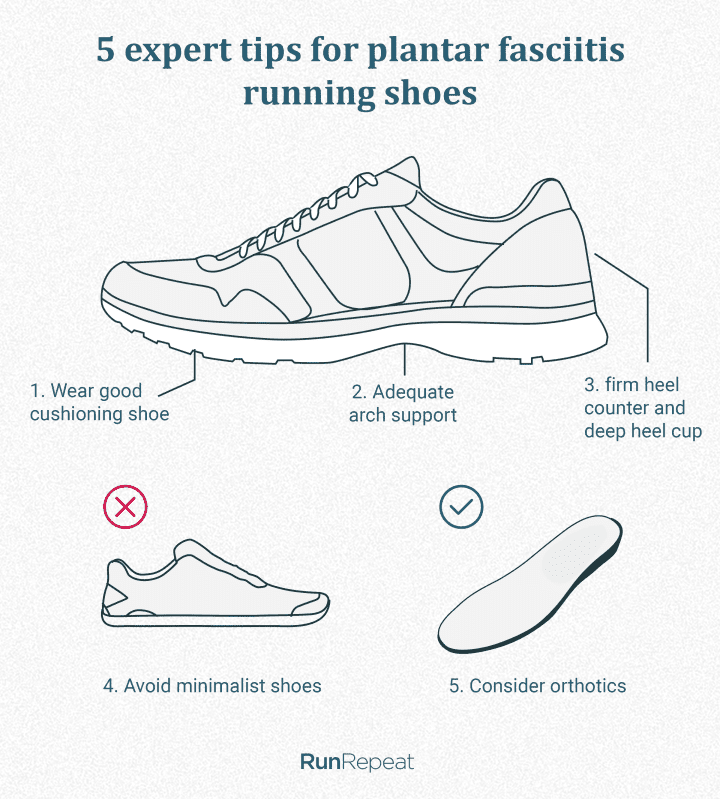
Good cushioning helps with pain relief
Cushioned running shoes will protect the plantar fascia from tension caused by repetitive impact while running. A reliable running shoe for plantar fasciitis offers excellent shock absorption as the foot strikes to the ground.
At the same time, it is not recommended to wear an overly plush shoe as it may cause instability in the foot and ankle.
Running shoes with balanced or firm cushioning are more suitable in the case of plantar fasciitis.
Adequate arch support is important
Arch support is one of the important elements to look out for if you have plantar fasciitis. No matter how expensive the shoe is, without proper arch support, the problem will continue.
Depending on the severity of the condition, arch support comes in different levels. Some running shoes are better for high arches while others are best for low arches; thus, it is important to find a shoe that matches your arch needs:
- If plantar fasciitis is accompanied by low arches/flat feet and overpronation, consider stability shoes. Previously, motion control shoes were recommended but they are more and more replaced with stability shoes now.
- For those with normal or high arches, it is more beneficial to wear a softer, neutral shoe.

neutral shoe (left) vs. stability shoe (center) vs. motion control shoe (right)
Robust heel counter stabilizes the feet
A firm heel counter reduces the abnormal stretching of the plantar fascia. It also stabilizes the feet and keeps them aligned. A flexible toe box goes well with a robust heel counter, allowing the front of the shoe to stretch while keeping the back of the foot strong and stable.
Runners with plantar fasciitis can also benefit from shoes with deep heel cups as it also protects the heel bone and reduces pronation.
Avoid minimalist running shoes
Minimalist running shoes are not recommended for runners with plantar fasciitis because they have less cushioning with little to no arch support.
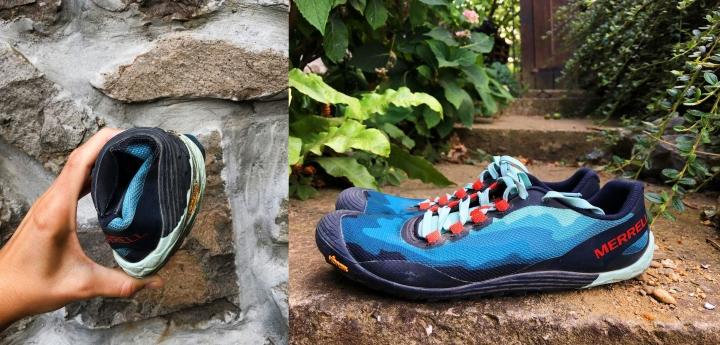
Merrell Vapor Glove is one of the most well-known minimalist shoes
Minimalist shoes are bad for both heel and forefoot strikers since there is no enough cushioning to lessen the impact forces.
Consider wearing orthotics
Orthotics provide additional arch support that your running shoe may lack and the deep heel cup helps absorbs impact in every step. Orthotics are also great in minimizing the tension on the plantar fascia.

Both custom and over-the-counter orthotics offer plantar fasciitis relief. If you wear custom orthotics, consider buying a shoe with a removable insole.
For more guidance on custom insoles and orthotics, see our ultimate guide.
Plantar fasciitis and flat feet: Are they related?
Plantar fasciitis and flat feet are often confused. They are not the same but they are related.
Flat feet, sometimes called fallen arches, refer to a foot condition in which the arches are flattened, so when standing, the soles of the feet touch the floor. Flat feet are linked with overpronation and those suffering from this condition are more likely to develop plantar fasciitis.

How to prevent plantar fasciitis
Prevention is always better than cure. Here are a few things to remember to avoid or address an early stage of plantar fasciitis.
- Do not wear uncomfortable shoes. Avoid heels and shoes with no support. Instead, choose running shoes with impact-absorbing heel support.
- Rest as soon as you notice discomfort during or after running. Avoid running and other impact sports for a few weeks.
- Keep doing leg and foot stretches.




